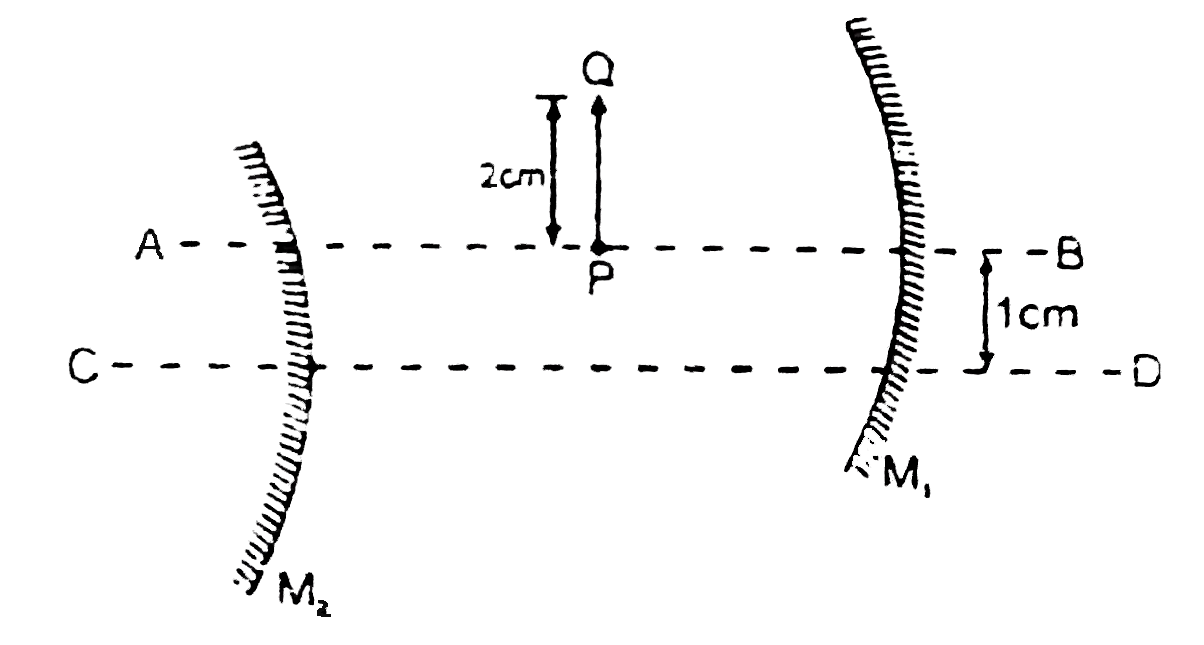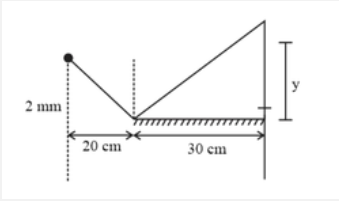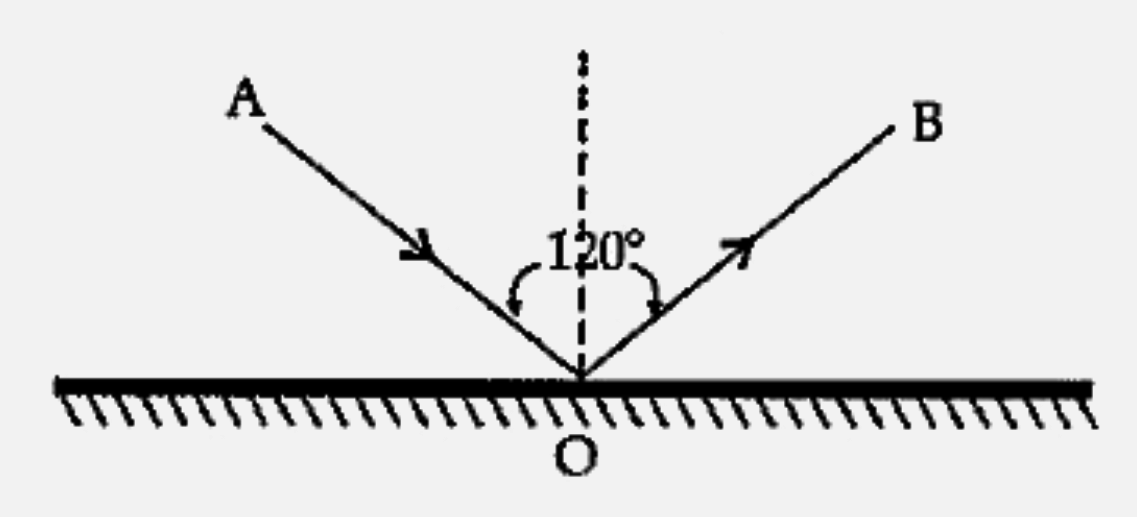A perfectly reflecting mirror has an area of 1cm2 Light enery is allowed to fall on it 1 h at the rate of 10Wcm2. The force that acts on the mirror is
3.35×10−8N
6.7×10−8N
1.34×10−7N
2.4×10−4N
The correct Answer is:B
To find the force acting on a perfectly reflecting mirror when light energy falls on it, we can follow these steps:
Step 1: Calculate the Energy Falling on the Mirror
Given that the light energy falls on the mirror at a rate of 10W/cm2 and the area of the mirror is 1cm2, we can calculate the power (energy per unit time) falling on the mirror.
Power=Intensity×Area
Power=10W/cm2×1cm2=10W
Step 2: Calculate the Total Energy Over Time
The energy falling on the mirror over 1 hour (3600 seconds) can be calculated as follows:
Energy=Power×Time
Energy=10W×3600s=36000J
Step 3: Calculate the Momentum of the Light
The momentum p associated with the energy E of the light can be expressed as:
p=Ec
where c is the speed of light (c≈3×108m/s).
Step 4: Calculate the Change in Momentum
Since the mirror is perfectly reflecting, the change in momentum Δp will be twice the momentum of the incoming light:
Δp=2p=2(Ec)
Step 5: Calculate the Force
The force F acting on the mirror is given by the rate of change of momentum:
F=ΔpΔt=2Ec⋅Δt
Substituting Δt=1second:
F=2×36000J3×108m/s=720003×108
Calculating this gives:
F=2.4×10−4N
Final Answer
Thus, the force that acts on the mirror is approximately 2.4×10−4N.
---
Given that the light energy falls on the mirror at a rate of 10W/cm2 and the area of the mirror is 1cm2, we can calculate the power (energy per unit time) falling on the mirror.
The energy falling on the mirror over 1 hour (3600 seconds) can be calculated as follows:
The momentum p associated with the energy E of the light can be expressed as:
Since the mirror is perfectly reflecting, the change in momentum Δp will be twice the momentum of the incoming light:
The force F acting on the mirror is given by the rate of change of momentum:
Thus, the force that acts on the mirror is approximately 2.4×10−4N.
Topper's Solved these Questions
- ELECTROMAGNETIC WAVESBOOK - DC PANDEY ENGLISHCHAPTER - ELECTROMAGNETIC WAVESEXERCISE - Sec B
5 Videos
- ELECTROMAGNETIC WAVESBOOK - DC PANDEY ENGLISHCHAPTER - ELECTROMAGNETIC WAVESEXERCISE - Match the columns
2 Videos
- ELECTROMAGNETIC WAVESBOOK - DC PANDEY ENGLISHCHAPTER - ELECTROMAGNETIC WAVESEXERCISE - Check point 8.2
15 Videos
- ELECTROMAGNETIC INDUCTIONBOOK - DC PANDEY ENGLISHCHAPTER - ELECTROMAGNETIC INDUCTIONEXERCISE - Medical entrances gallery
25 Videos
- ELECTROSTATIC POTENTIAL AND CAPACITORSBOOK - DC PANDEY ENGLISHCHAPTER - ELECTROSTATIC POTENTIAL AND CAPACITORSEXERCISE - (C) Chapter exercises
50 Videos
Similar Questions
A narrow beam of monochromatic light of wavelength λ emitted from a source of power P is propogating in the positive x-direction. After being reflected from a perfectly reflecting plane mirror of area vector →A=A(−ˆi−ˆj), the beam falls on a metal plate of surface area A[→A is along outward normal at mirror]. the force exerted by light beam on the mirror is →F and Δ→p is change in momentum of each photon then [cis speed of light in vacuum]
View SolutionSize of image of an object by a mirror having a focal length of 20cm is observed to be reduced to 13rd of the size ? At what distance the object has been placed from the mirror ? What is the nature of the image and the mirror ?
View SolutionAn object is placed 42 cm, in front of a concave mirror of focal length 21 cm. Light from the
concave mirror is reflected onto a small plane mirror 21 cm in front of the concave mirror
Where is the final image?
View SolutionA small status has a height of 1cm and is placed in front of a spherical mirror. The image of the statue is inverted and is 0.5cm tall and located to 10cm in front of the mirror. Find the focal length and nature of the mirror.
View SolutionAn object is placed 21 cm in front of a concave mirror of radius of curvature 10cm. A glass slabe of thickness 3cm and refractive index 1.5 is then placed close to the irror in the space between the object and the mirror. The distance of the near surface of the slabe from the mirror is 1cm. The final image from the mirror will be formed at
View SolutionIn the figure shown M1 and M2 are two spherical mirrors of focal length 20cm each. AB and CD are their principal axes respectively which are separated by 1cm.PQ is an object of height 2cm and kept at distance 20cm from M1. The separation between the mirrors is 50cm Consider two successive reflections first on M1 then on M2. Find the size of the 2nd image. Also find distances of and points P'' and Q'' of that image from the line AB.
 .
.
View SolutionA plane mirror of length 30 cm is placed horizontally along with a vertical screen. A monochromatic point source of light is placed 20 cm to the left off the left edge of the mirror, at a height of 2 mm above the plane of the mirror. If the wavelength of light used is 6400Å, then find the number of complete bright fringes formed.

View SolutionThe diagram below shows a light ray striking and reflecting from a plane mirror AO is the incident ray and OB the reflected ray. The angle between the incident ray and the reflected ray is 120∘.

If the image of an object is formed 5 cm behind the mirror, what is the distance between the image and the object?
View SolutionLight with an enargy flux of 25×104Wm−2 falls on a perfectly reflecting surface at normal incidence. If the surface area is 15cm2, the average force exerted on the surface is
View SolutionA point source of light is 60 cm from a screen and is kept at the focus of a concave mirror which reflects light on the screen. The focal length of the mirror is 20 cm. The ratio of average intensities of the illumination on the screen when the mirror is present and when the mirror is removed is:
View Solution
